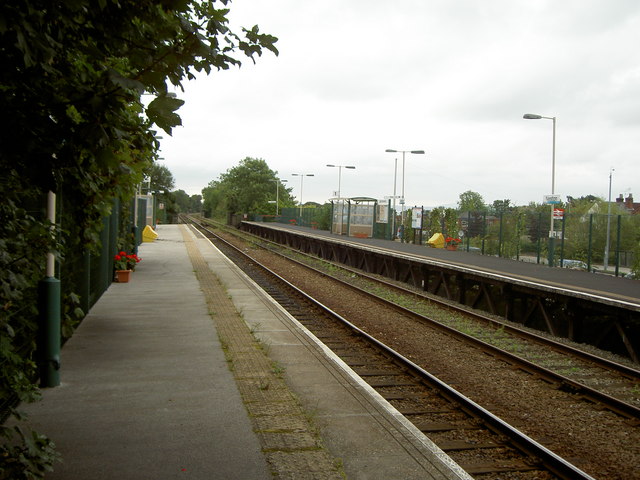|
Neston Railway Station
Neston railway station serves the town of Neston, Cheshire, England. It is the southernmost station on the English part of the Borderlands Line before it reaches Wales. The station is 8¾ miles (14 km) south of Bidston. History There was once a substantial station building on the Bidston bound platform. This fell into disrepair in the late 1990s though, and was finally demolished when the station was modernised for Disability Discrimination Act compliancy in 2003. Future Long standing plans to electrify the Borderlands Line have been put on hold due to the prohibitive cost of installing third rail electrification. This has led Merseytravel to look at other options for the line, including the possibility of overhead lines. Facilities The station is unstaffed and only 'bus shelter' type structures offer passengers any protection from the elements. Bus interchange is available from the stop on Ladies Walk adjacent the Bidston bound platform. This is also from wher ... [...More Info...] [...Related Items...] OR: [Wikipedia] [Google] [Baidu] |
Neston
Neston is a town and civil parish on the Wirral Peninsula, in Cheshire, England. It is part of the unitary authority of Cheshire West and Chester. The village of Parkgate is located to the north west and the villages of Little Neston and Ness are to the south of Neston. At the 2001 census the population of Neston ward was recorded as 3,521, increasing to 4,329 at the 2011 census. The civil parish also includes Little Neston, Parkgate, Willaston and part of Burton and Ness, and had a population of 15,162 in 2001, increasing to 15,221 in 2011. History The name is of Viking origin, deriving from the Old Norse ''Nes-tún'', meaning 'farmstead or settlement at/near a promontory or headland'. Another Nesttun town can be found near Bergen, Norway. It is also mentioned in the Domesday Book as ''Nestone'' under the ownership of a William Fitznigel, with a population of eight households. Civic history A royal charter was granted to Neston in 1728 in support of its status as a ... [...More Info...] [...Related Items...] OR: [Wikipedia] [Google] [Baidu] |
British Rail Class 150
The British Rail Class 150 ''Sprinter'' is a class of diesel multiple unit passenger trains; they were developed and constructed by BREL York between 1984 and 1987 for use on regional services across the UK. The type is a second-generation design, built to more modern standards and based on BR's Mark 3 body design for longer-distance services. It was developed alongside the lower-cost ''Pacers'', which were built using bus parts, for use on short-distance services. Two prototype units were built, followed by 135 production units in two batches. Subsequently, further members of the Sprinter family were also developed and introduced to service, including the Class 155, Class 156, Class 158 and Class 159. Background By the beginning of the 1980s, British Rail (BR) was operating a large fleet of first-generation DMUs of various designs. While formulating its long-term strategy for this sector of its operations, BR planners recognised that there would be considerable costs ... [...More Info...] [...Related Items...] OR: [Wikipedia] [Google] [Baidu] |
Railway Stations In Great Britain Opened In 1896
Rail transport (also known as train transport) is a means of transport that transfers passengers and goods on wheeled vehicles running on rails, which are incorporated in tracks. In contrast to road transport, where the vehicles run on a prepared flat surface, rail vehicles (rolling stock) are directionally guided by the tracks on which they run. Tracks usually consist of steel rails, installed on sleepers (ties) set in ballast, on which the rolling stock, usually fitted with metal wheels, moves. Other variations are also possible, such as "slab track", in which the rails are fastened to a concrete foundation resting on a prepared subsurface. Rolling stock in a rail transport system generally encounters lower frictional resistance than rubber-tyred road vehicles, so passenger and freight cars (carriages and wagons) can be coupled into longer trains. The operation is carried out by a railway company, providing transport between train stations or freight customer facil ... [...More Info...] [...Related Items...] OR: [Wikipedia] [Google] [Baidu] |

